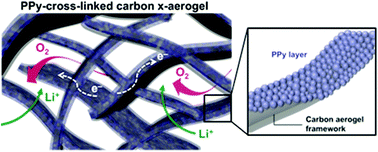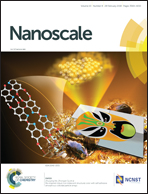Synergy of polypyrrole and carbon x-aerogel in lithium–oxygen batteries†
Abstract
A crucial step in the development of lithium–oxygen (Li–O2) batteries is to design an oxygen cathode with high catalytic activity and stable porous structure. Achieving such design requires an integrated strategy in which porosity, conductivity, catalytic activity, and mechanical durability are all considered in a battery system. Here, we develop polypyrrole-coated carbon x-aerogels with macroscopic 3D architecture, and demonstrate their potential as oxygen cathodes for Li–O2 batteries. This material, a novel and mechanically strong composite aerogel with polymer-cross-linked structure, not only provides effective pores that allow to store the discharge products and open channels for better oxygen diffusion, but also forms a robust 3D catalytic network that promotes both oxygen reduction and evolution reactions with improved mechanical and electrochemical stability. This work highlights the synergy between the 3D porous, conductive carbon aerogel framework and the polypyrrole catalytic layer, which maintains stable catalytic activity without deactivation and provides a more effective gas–liquid–solid interface for rapid oxygen absorption and diffusion, thereby leading to significant improvements in the capacity, rate capability and cycle life of the cathode.



 Please wait while we load your content...
Please wait while we load your content...